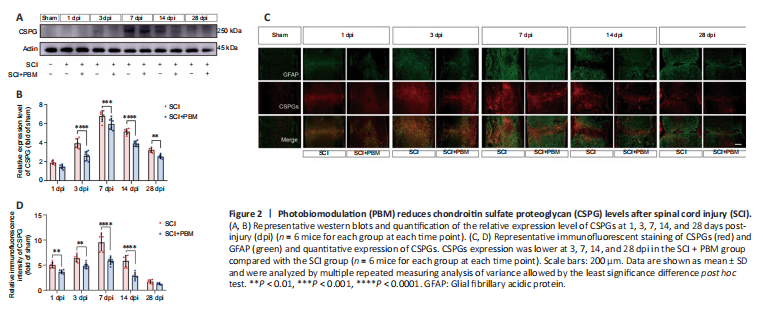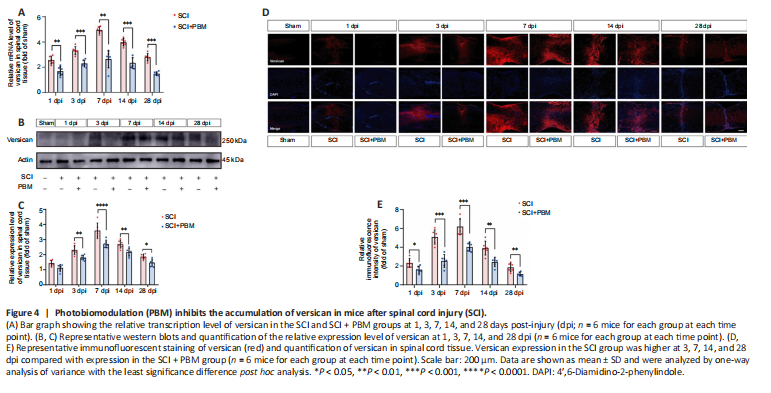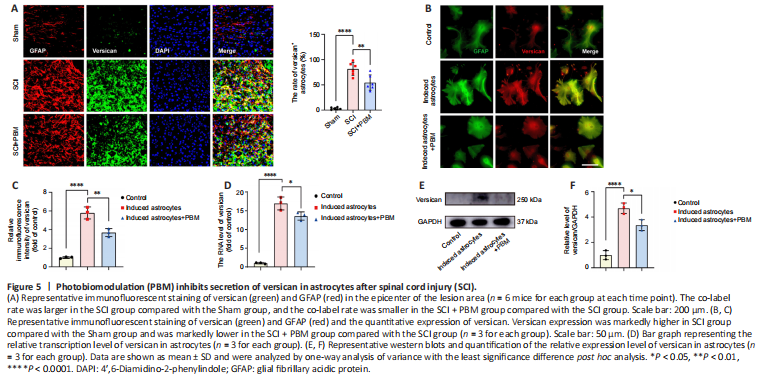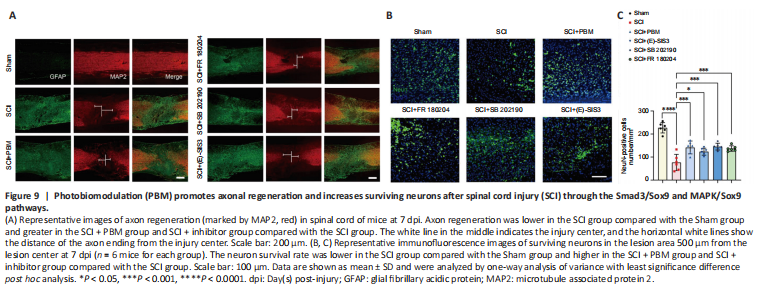脊髓损伤
-
Figure 2|Photobiomodulation (PBM) reduces chondroitin sulfate proteoglycan (CSPG) levels after spinal cord injury (SCI).

A previous study reported that PBM markedly decreased the expression level of CSPGs in SCI model rats at 7 days post-injury (Sun et al., 2020), The effect of PBM irradiation on CSPGs was first evaluated by western blot assay (Figure 2A and B). CSPGs accumulated rapidly after injury, peaked at 7 days post-injury, and then gradually decreased over 28 days. PBM irradiation reduced the accumulation of CSPGs in the injured spinal cord; the expression of CSPGs was markedly reduced in the PBM irradiated group compared with the SCI group at 3, 7, 14, and 28 days post-injury. We assessed the effect of PBM irradiation on CSPG spatial expression in spinal cord samples using immunofluorescence (Figure 2C and D). The expression of CSPGs was mainly concentrated in and around the injury center; it increased in the acute period after SCI and gradually decreased in the sub-acute period. PBM treatment markedly decreased CSPG expression at 3, 7, 14, and 28 dpi in the SCI + PBM group compared with the SCI group. These data suggest that PBM irradiation reduces the accumulation of CSPGs after SCI.
Figure 4|Photobiomodulation (PBM) inhibits the accumulation of versican in mice after spinal cord injury (SCI).

Versican is a widely expressed transitional matrix proteoglycan that plays an important role in biological processes such as developmental morphogenesis and reproduction (McCulloch et al., 2009; Dupuis et al., 2011). Early in the inflammatory process, an increase of versican often coincides with leukocyte invasion. Versican plays a role in promoting the inflammatory response either indirectly through hyaluronic acid or by directly interacting with inflammatory cells (Wight et al., 2020). In multiple sclerosis, versican is one of the CSPGs responsible for repair inhibition and the promotion of local inflammation to exacerbate injury (Ghorbani et al., 2022). We next investigated the changes of versican expression at different time points after SCI. qPCR results showed that compared with the expression level in mice in the Sham group, versican mRNA expression in the SCI group peaked at 7 days post-injury and was gradually downregulated at subsequent time points, and PBM intervention markedly downregulated versican mRNA expression at 3, 7, 14, and 28 days post-injury (Figure 4A). Consistent with the qPCR results, western blotting (Figure 4B and C) and immunofluorescence staining (Figure 4D and E) also demonstrated that versican expression increased 7 days post-injury and then gradually decreased over 28 days; versican expression was obviously lower in the SCI + PBM group than in the SCI group. These results confirm that versican expression was elevated after injury and markedly down-regulated by PBM irradiation.
Figure 5|Photobiomodulation (PBM) inhibits secretion of versican in astrocytes after spinal cord injury (SCI).

Our results suggested that versican might be a key proteoglycan targeted by PBM intervention following SCI. This prompted us to investigate versican-expressing cells that may be targeted by PBM. CSPG is the main component of glial scarring and is secreted by reactive astrocytes after SCI (Bradbury et al., 2002; Silver and Miller, 2004). Our previous study showed that PBM inhibits the inflammatory activation of astrocytes to alleviate the inflammatory response after SCI (Wang et al., 2021b). We next examined the expression of versican in astrocytes after SCI and investigated the effect of PBM intervention on versican expression. The spinal cord tissue in the SCI group was stained with the astrocyte marker GFAP and versican. Versican was detected in astrocytes at 7 days post-injury, and PBM irradiation reduced versican expression (Figure 5A). We also performed in vitro studies in astrocytes after inflammatory induction. Immunofluorescence (Figure 5B and C), qPCR (Figure 5D), and western blotting (Figure 5E and F) also showed increased versican expression in astrocytes after inflammation stimulation, and the expression was obviously decreased after PBM intervention. Taken together, these data suggest that PBM is an exogenous stimulus that can reduce the level of versican expression in astrocytes.
Figure 9|Photobiomodulation (PBM) promotes axonal regeneration and increases surviving neurons after spinal cord injury (SCI) through the Smad3/Sox9 and MAPK/Sox9 pathways.

Higher amounts of axonal regeneration were observed in the SCI + PBM, SCI + inhibitors, and SCI + PBM + inhibitors groups compared with the SCI group (Figure 9A). The number of surviving neurons was measured within 0.5 mm of the para-lesion area, and the results showed that at 7 days post-injury, the SCI + PBM, SCI + FR 180204, SCI + SB 202190 and SCI + (E)-SIS3 groups had more surviving neurons in the para-lesion area than the SCI group (Figure 9B and C).